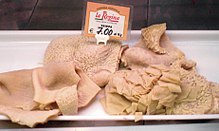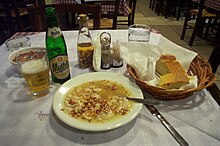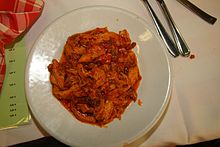Tripe: Difference between revisions
m Reverted edits by 81.132.172.221 to last version by J.delanoy (HG) |
Czech Dršťkovka |
||
| Line 21: | Line 21: | ||
* ''[[Chakna]]'' — [[Indian cuisine|Indian]] spicy stew of goat tripe and other animal parts |
* ''[[Chakna]]'' — [[Indian cuisine|Indian]] spicy stew of goat tripe and other animal parts |
||
* ''[[Dobrada]]'' — [[Portuguese cuisine|Portuguese]] tripe dish usually served with white butterbeans and chouriço |
* ''[[Dobrada]]'' — [[Portuguese cuisine|Portuguese]] tripe dish usually served with white butterbeans and chouriço |
||
* ''[[Dršťkovka]]'' — [[Czech cuisine|Czech]] [[goulash]]-like tripe soup |
|||
* ''[[Fileki]] or [[špek-fileki]]'' — [[Croatia|Croatian]] tripe soup. |
* ''[[Fileki]] or [[špek-fileki]]'' — [[Croatia|Croatian]] tripe soup. |
||
* ''[[Flaczki]]'' — [[Polish cuisine|Polish]] soup, with [[marjoram]] |
* ''[[Flaczki]]'' — [[Polish cuisine|Polish]] soup, with [[marjoram]] |
||
| Line 45: | Line 46: | ||
* ''[[Trippa alla Romana]]'' — in Italy (done with white wine and tomatoes) |
* ''[[Trippa alla Romana]]'' — in Italy (done with white wine and tomatoes) |
||
* ''Tsitsarong bulaklak'' — Filipino crunchy fried tripe (lit. "flower" crackling) |
* ''Tsitsarong bulaklak'' — Filipino crunchy fried tripe (lit. "flower" crackling) |
||
* ''[[Yakiniku]]'' and ''[[Horumonyaki]]'' — [[Japanese cuisine|Japanese]] chargrilled, bite-sized |
* ''[[Yakiniku]]'' and ''[[Horumonyaki]]'' — [[Japanese cuisine|Japanese]] chargrilled, bite-sized |
||
== References == |
== References == |
||
Revision as of 08:22, 7 January 2009

Tripe is a type of edible offal from the stomachs of various domestic animals[1].
Description
Beef tripe is usually made from only the first three chambers of a cow's stomach: the rumen (blanket/flat/smooth tripe), the reticulum (honeycomb and pocket tripe), and the omasum (book/bible/leaf tripe). Abomasum (reed) tripe is seen much less frequently, owing to its glandular tissue content. Tripe is also produced from sheep, goats, pigs, and deer. Unwashed (or "green") tripe includes some of the stomach's last content, giving it an unpleasant odor and causing it to be considered unfit for human consumption[citation needed]. However, this content is desirable to dogs and many other carnivores and is often used in pet food[citation needed]. Though it is called "green," its colour is often brown or grey because of its high chlorophyll content from undigested grass.
For human consumption, tripe must be washed and meticulously cleaned.
Dishes




Tripe is eaten in many parts of the world. Tripe dishes include:
- Andouille — French poached and smoked cold tripe sausage
- Andouillette — French grilling sausage including pork or beef tripe
- Butifarra — Catalonian sausage
- Callos — Spanish tripe dish cooked with garbanzos, chorizo and pimentón.
- Chakna — Indian spicy stew of goat tripe and other animal parts
- Dobrada — Portuguese tripe dish usually served with white butterbeans and chouriço
- Dršťkovka — Czech goulash-like tripe soup
- Fileki or špek-fileki — Croatian tripe soup.
- Flaczki — Polish soup, with marjoram
- Fuqi feipian A spicy Chinese cold-cut dish made from various beef offals, nowadays mainly different types of tripe and tongue.
- Guru (food) — Zimbabwean name for tripe. Normally eaten as relish with Sadza.
- Haggis — Scottish traditional dish made of a sheep's stomach stuffed with oatmeal and the minced heart, liver and lungs of a sheep. The stomach is used only as a vessel for the stuffing and is not eaten.
- İşkembe çorbası — Turkish tripe soup with garlic, lemon and spices
- Kare-kare — Filipino oxtail-peanut stew which may include tripe
- Kista — Assyrian Cooked traditionlly in a stew and stuffed with soft rice. This dish is part of a major dish known as 'Pacha' in Assyrian.
- Lampredotto — Florentine abomasum-tripe dish, often eaten in sandwiches with green sauce and hot sauce.
- Menudo — Mexican sheep tripe stew
- Mondongo — Latin American and Caribbean tripe, vegetable and herb soup
- Pacal or Pacalpörkölt — Hungarian spicy meal made of tripe, similar to pörkölt
- Paklay — Filipino all-time Filipino Favorite dish
- Pancitas — Mexican stew similar to Menudo but made with cow stomach
- Patsás (Greek πατσάς) — Greek, similar to Turkish İşkembe
- Philadelphia Pepper Pot Soup — American (Pennsylvania) tripe soup with peppercorns
- Phở — Vietnamese soup
- Saure Kutteln — from south Germany, made with beef tripe and vinegar or wine
- Shkembe (Shkembe Chorba) — is a kind of tripe soup, prepared in Bulgaria, Romania, Republic of Macedonia, Serbia and Turkey.
- Tripas à moda do Porto — tripe with white beans, in Portuguese cuisine, a dish typical of the city of Porto.
- Tripe and Drisheen — in Cork, Ireland
- Tripoux — French sheep tripe dish
- Trippa alla Romana — in Italy (done with white wine and tomatoes)
- Tsitsarong bulaklak — Filipino crunchy fried tripe (lit. "flower" crackling)
- Yakiniku and Horumonyaki — Japanese chargrilled, bite-sized
References
- ^ "Troppa Trippa". History of tripe, worldwide tripe recipes. Neri Editore, Firenze. 1998. Retrieved 2007-07-21.
